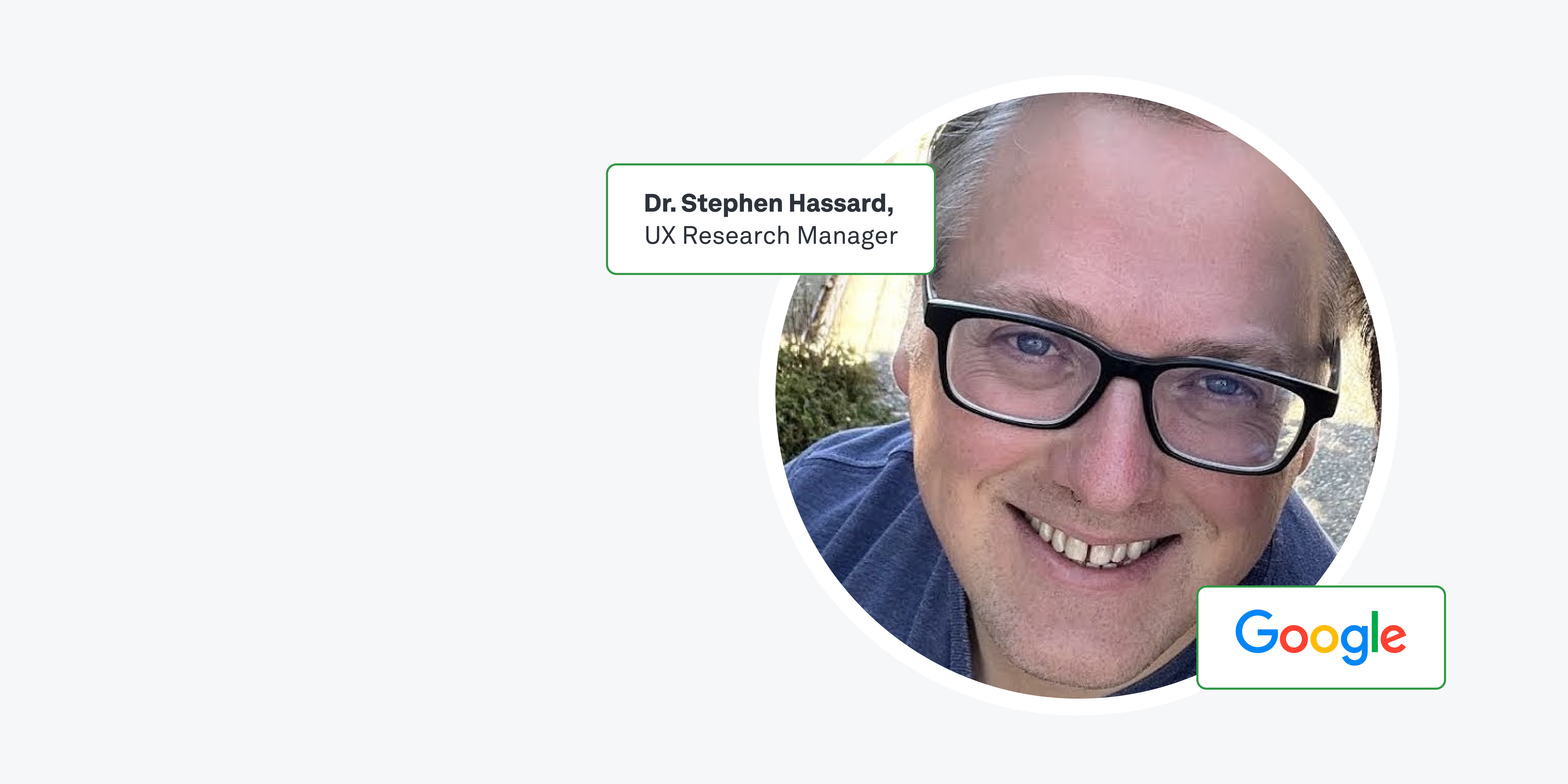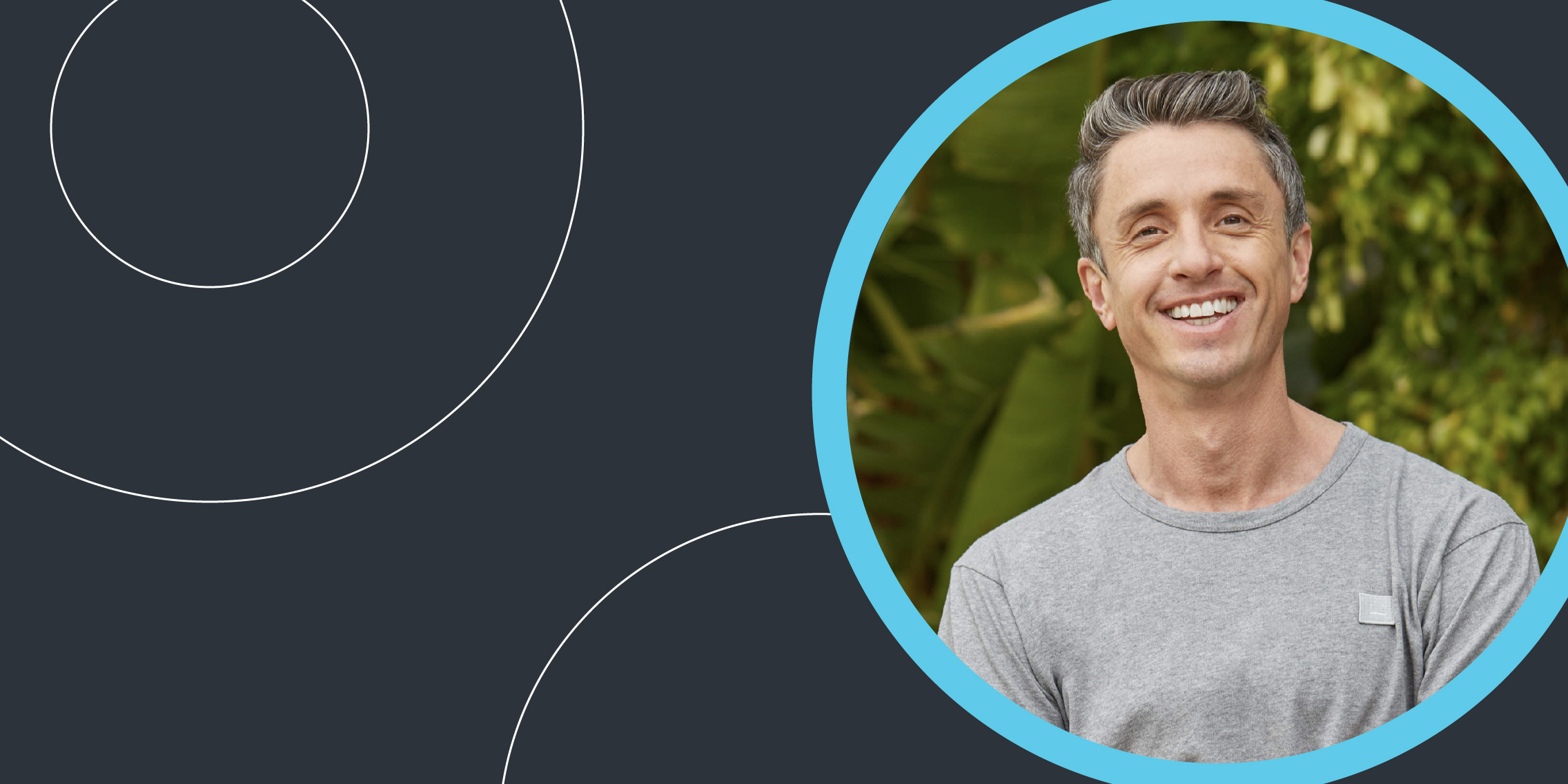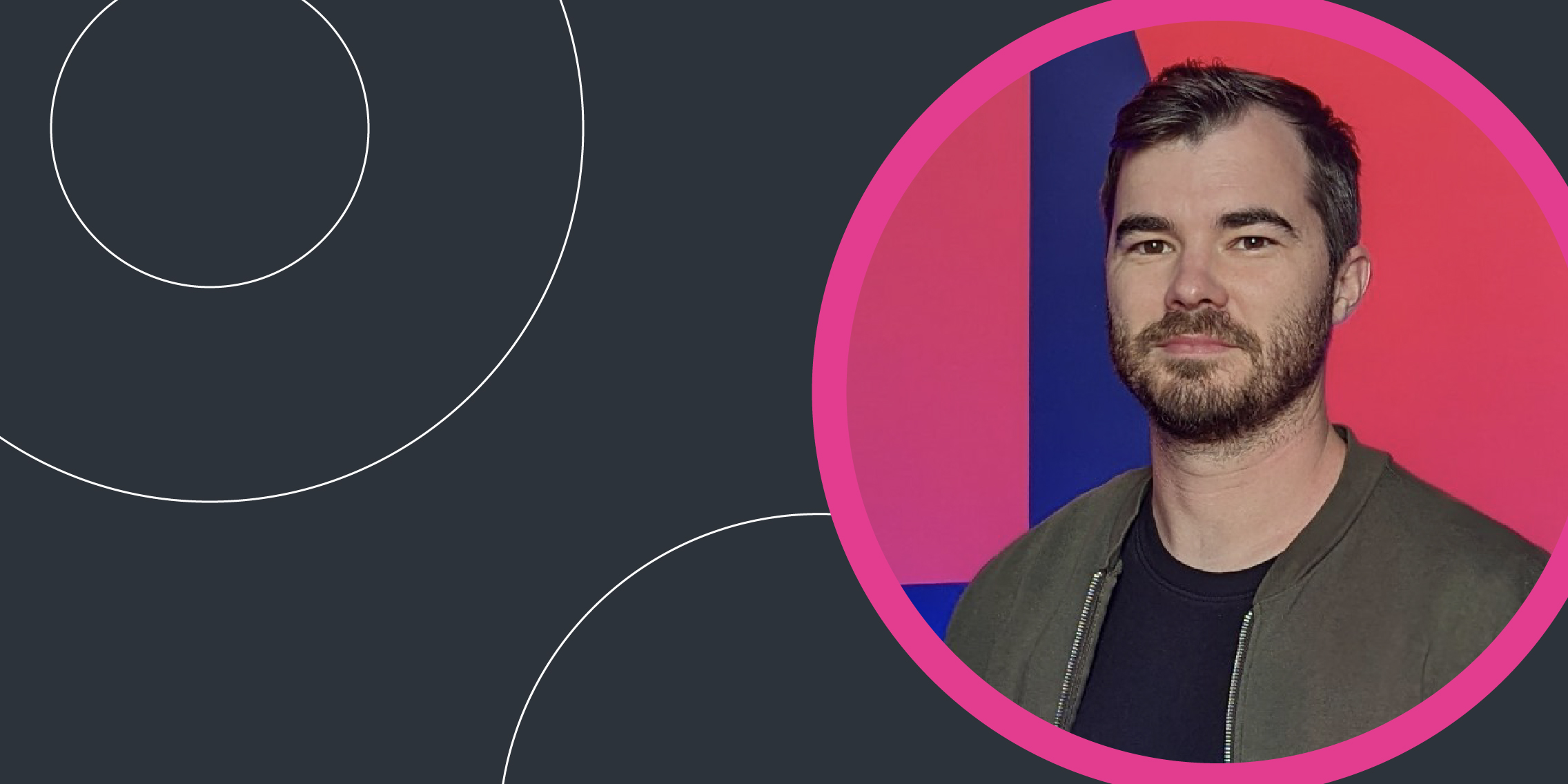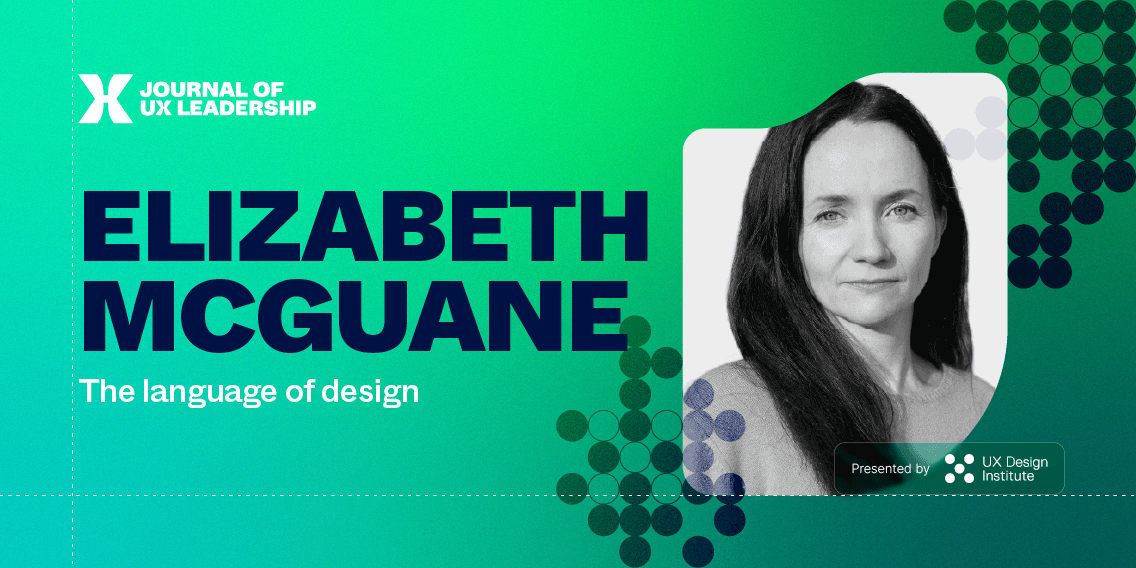Dr. Stephen Hassard is a UX Research Manager at Google and a lecturer in the Design School at the University of Kansas. We had an excellent chat with him as part of our UX Insiders series.
Stephen has been working and teaching in the field for over 15 years for such companies as YouTube, Garmin and Ubisoft. He also taught at University College London, University of Winnipeg and the Google TechExchange programme. He then traded London for Southern California… but he still misses the kebabs.
You can watch the full event through this link but here are some of the highlights from our conversation.
Could you tell us a little bit about your background before Google? And so what did you study? And kind of what working experience led you up to the position that you’re in?
I feel like pretty much most people in UX, you kind of fall into it in a very roundabout way. So when I started my undergrad, I started in computer science. And I had this thought in my second year of computer science: “Do I want to be programming eight hours a day, five days a week? That actually sounds like my idea of living hell”. And this is not to knock on programmers – this is not something I enjoy.
I happened to be taking psychology courses at the time just for something to do. Back then it was called human computer interaction – to totally date myself. And I was like, “Oh, that’s a thing. I’m taking psychology. I’m taking computer science. Let’s try that”.
Because of where I was living in Canada at the time – [UX was a] very small market, a very new area – I had to basically move out of there to start to get into that field. So, I moved to London and I did my PhD in Human-Computer Interaction at the University College of London.
When you do a PhD, there’s a moment where you ask “do I stay in academia? Do I go to industry?” And so I decided to stay in academia for a little while. I did that. I enjoy teaching. I still teach, but then I just realised “I don’t want to be doing this”. So, I pivoted to industry. I was doing some contract stuff originally and then got a job at Garmin… and then I got headhunted from Garmin to Google, which in itself was a weird story.
Go on…
I don’t take LinkedIn that seriously, I never really have. And I got a message one day on LinkedIn from Google, “Do you want to talk to Google?” And I was like, “Yeah, right, Google. Thanks. Do you need me to send you some money for a PlayStation Five that I can’t come pick up at your apartment? Sure thing, Google, let’s talk.”
Turns out it really was Google and not a crazy phishing scam. And so we go through these talks but I think with a lot of big tech companies, there’s a lot of secrecy around it. And so I go through all the things, expecting it to blow up in my face at some point and eventually, they’re like, “Hey, do you want to come in for an interview?” “Oh, crazy. I never thought I’d make it this far.”
Like, I still have no idea what I’m interviewing for. And I eventually get in location, I do the interview. It’s the very last interview of the day and it’s with the guy who would be my manager in this role. As I’m talking to him, we have this very awkward moment where we both realise everyone has grossly misinterpreted my background.
You could tell he’s like, “this is not the job for you because we totally thought it was this and this…”. I was like “if I’d known you thought it was that, then I would have told you that three months ago”. So it was awkward and, you know, clearly it blew up in my face.
But, in the end, they’re like, “So, you were not a good fit for that job at all… but are you still interested in something?” And I’m like, “Sure, I’ll be the janitor or Google. I don’t care.” And yeah! I kind of fell into it. Very, very backwards. So totally unexpected. I didn’t apply. And I got hired for a job. I was an absolute failure basically.
Were you always interested in design?
I would say that I was pretty obsessed with design from a pretty early age. Despite the kind of North American accent, I’m originally from Northern Ireland. So I grew up reading the Beano and Dandy comics.
So I was pretty obsessed with comic books as a kid and that’s where it kind of started. But I think where I pivoted into becoming obsessed with design was architecture.
I became – and still am – weirdly obsessed with McMansions. And just like very bad architecture drives me nuts. Because I’m a comic book nerd, I self-taught a lot of Photoshop, a lot of that Adobe Suite, which definitely came in handy. But the one thing I will say if people are looking to expand their brain about UX thinking, I always say Scott McCloud’s Understanding Comics is the best book about UX that is not about UX.
What led you to UX?
I think it was mostly that intersection of design and psychology.
And I just happen to have a computer science skill set. I knew enough to be dangerous in terms of prototyping and just understanding the technical conversations with stakeholders. I don’t know, it just always felt like that’s where I was going to go. So I don’t know, in some ways, it just felt like that was always the plan.
At what point did you begin specialising in research?
I’ll answer this question in a backwards way. So, at Google, I’m a specialised UX researcher. Previous to that, when I was a Garmin, I was split. I did research and I did design, which is pretty common in what are referred to as midsize companies, although I had a specialisation in research. But previous to that, I just happened to have lots of jobs around research, so I tend to enjoy doing stats.
I kind of fell into the field just by helping people with their stats work. And then from there, I just built up this expertise within research, just almost by accident. I don’t think if I had had that initial, accidental jump into research, I probably would have been way more on the design side than I am now.
What differentiates user research from academic research?
So in terms of the skill set, there’s no difference. The only piece of the puzzle that’s missing is what I refer to as “thrown over the fence research”. And what I mean by this is in academia, you do research and then everyone stares at it. And then you say, “Isn’t this amazing? Is this not the greatest thing you’ve ever seen?” And you expect everyone to be so bowled over by how amazing your research is. Then people can talk about it for years and months.
And industry… that’s not at all how it goes. You could produce an amazing report and everyone would stare at it and be like, “What?” I go, “What? It’s amazing. Look at it. Is this not amazing?” And they’re like, “Okay, all right. Next thing, I don’t care”.
It’s about taking a finding and making it applicable and actionable. I think the big difference between academic research and industry research is the specificity in the action, the actual ability of it.
When I was an IC researcher, I would easily say 60 to 70% of my workload was convincing people that they need to care about this research. It’s by far the most amount of work that I do compared to actually doing the research. Doing the research is important – clearly – but it’s a smaller part of the work process than I think everyone appreciates or understands.
Could you talk us through your daily responsibilities and what an average day as a UX researcher manager looks like?
So I manage a team of UX researchers. So if I was to just answer what my day looks like… I sit in meetings for about seven hours of the day but that’s mostly because I’m a manager, which is not interesting. No one wants to hear the various tales of me sitting staring at the wall and listening to stakeholders talk.
As a researcher, there’s a few different types of work; tactical, strategic, and design. Those all fall in different spots in the design cycle and everyone, I think, has a particular strength.
I tend to like design type problems, some people like the tactical stuff, which is mostly where junior researchers tend to start. And then there’s the strategic stuff, which is coming up with the next thing we should be working on.
I should probably define what those things are. So strategic is, what should we be working on six months ahead. Design is… how do we produce the best solution that meets a real user.
And then tactical is what most people think of when they think research. That’s when you show someone a prototype and they’re like, “I don’t understand this button”. And you’re like [mimics taking down notes], “Well, okay, doesn’t understand button”. They say, “This button won’t click”, and you note, “this button won’t click”, which is great. It keeps lights on, it makes products more usable but that is very kind of nuts and bolts.
Could you give us an idea of what your team looks like and the other teams that you collaborate with the most?
So my team is probably, I would say, a fairly normal sized research team at Google. We tend to have around four to five people per manager, maybe up to six. It’s relatively rare to get a team bigger than that under one manager.
So I have a team of five researchers underneath me and they’re roughly assigned to a particular problem area. So each one has a particular domain that they become an expert in.
My team tends to work very closely with the UX design team, to the point that we have actually kind of established official partnerships. So this designer is paired with this researcher.
That is, ideally one designer, one researcher. Rarely does that work out. At the minute, I think my researchers are supporting two designers each. I think I’ve got one researcher supporting three. So, that’s a lot of tactical evaluative stuff there.
When we think about strategic stuff, that’s where we partner with project managers. Some orgs call them product managers, it just depends on how a particular title is being used in a particular organisation. So, for example, when I was at YouTube, I would actually work more with project managers.
Now that I’m in Google, where I do some internal tools stuff, I tend to partner more with designers. Not that I don’t partner with project managers, but just the balance is a little bit different.
Which qualities should a researcher have to gain the trust of their colleagues? And is there a master plan for convincing others?
The main skill, I personally believe, is storytelling. Can you create a compelling and convincing narrative? Now, to your point, is there a master plan? There is actually. At least I feel like there is.
There’s a book called It’s Our Research by Tomer Sharon. And it is an absolute freakin’ legend of a book if you want to get into research. Specifically, if you’re a designer and you want to work with stakeholders. He basically lays out all of the steps you should be doing in terms of who you should be talking to, when you should be talking to them and how do you get stakeholders involved? It is not the hero we deserve but it’s definitely the hero we need. It’s a friggin’ amazing book.
What advice do you have for aspiring UX researchers?
Show your thought process. Don’t focus on hero shots. I think if there’s anything I want people to listen to and really internalise is that people fall for the siren call of high fidelity stuff. Don’t. You can do some super cool stuff with nothing more than a napkin and a pencil. And I’ll be blown away by it.




